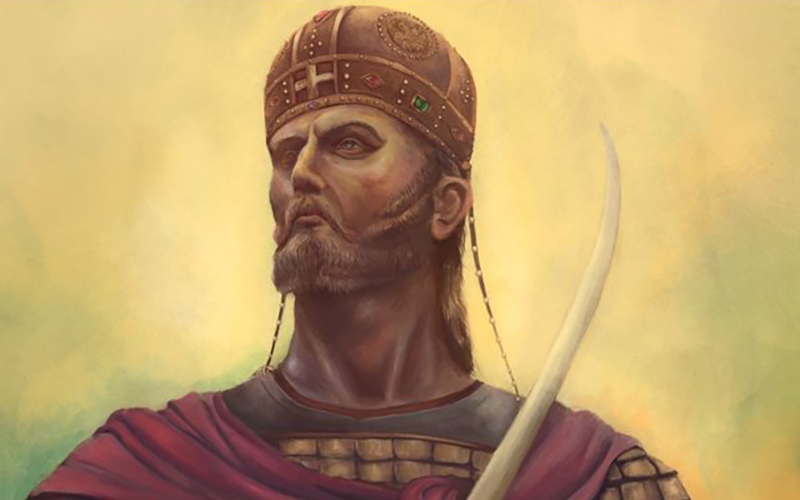Prologue
Eastern Roman Empire managed to hold on for almost a thousand years more than the Western part. Mighty Byzantine Empire was a reminder to mankind how relentless and cruel the wheel of history can be.
Constantinople was founded by Constantine the Great in 330. A.D. Walls of this magnificent city had witnessed many turning points in history and endured and overcome many dangerous situations and challenges.
From Atilla’s savage plundering quests, Avar-Slavic siege 626. A.D., repelling Bulgarian hoards under Krum, surviving Arabian attacks, and overcoming religious problems over icons.
The first serious blow to the Empire was the loss of Asia Minor after the defeat in the Battle of Manzikert (1071), another even worst was the first fall of Constantinople in 1204 into the hands of Crusaders (1204). The empire was re-established again in 1268 during the rain of Michael VIII Palaiologos.
Dying Empire
Since the Battle of the Maritsa River (1371) Byzantine Empire is submitted to the will of the Ottoman Sultan Murad I. Serbian lords of Macedonia despot Ugljesa and King Vukasin were defeated and nothing could stop the Ottomans in their further expansion to the Balkan Peninsula.
The Byzantine Empire was affected by civil wars and fights for the throne between various pretenders during the mid-fourteen century. Ottoman sultans supported these interior disturbances between the last emperors and Byzantine was never able to have their foreign policy and they were not able to rule without the blessing and support of the Ottoman sultans.
Emperors Manuel II Palaiologos and his son John VIII Palaiologos were actively seeking help from Western countries and rulers. Manuel II and his son participated in diplomatic missions to get financial and military help but their efforts were fruitless.
After the Crusaders’ army was defeated at the Battle of Nicopolis in 1396. A.D. none in the Western countries was seriously considering another military quest.
All they got were empty promises and encouraging words. Later in 1399, Constantinople was attacked by Sultan Bayezid from the land, but the assault was repelled with great effort. After the Battle of Angora 1402 Bayezid was defeated by the Emir of the Timurid Empire, Timur. Civil war erupted between Bayezid’s successors.
That was a short brief for the crumbling Byzantine empire to gather some strength. New Sultan Murad II emerge victorious and tried to siege Constantinople, this time using canons, but he had no success.
John VIII signed a document, today known as the Florentine Union(1439) where the principle of the pope’s supremacy had to be accepted. That was the ultimate condition for any kind of help from the West, church union was never fully accepted and implemented. Lower clarity and common people resisted stubbornly to this document, while higher clarity and aristocracy supported a more practical approach to this question.
The Last Roman Emperor

Constantin XI Palaiologos , son of Manuel II and Serbian princess Jelena Dragas is destined to become the last ruler of the stumbled empire. The first time he was mentioned as a regent of Constantinople while his older brother was occupied by diplomatic missions visiting Western countries.
Before becoming an Emperor, he was the despot of Morea (Peloponnese) and shared this title with his brothers, Theodor and Thomas. Constantin proved himself as an excellent administrator and military leader.
He conquered parts of the peninsula under the control of local Latin lords like Carlo Toko and Pandolfo Malatesta. He gained territories in Laconia, Kalamata, Messenia, and Patras (1429).
1443. Constantin XI Palaelogus switched his lands in Selemvria and other areas around the Black Sea with his older brother Theodor Palaelogus. He became lord of Mystra and he was related to Cardinal Julio Cesarini and Janosh Hunyadi, leaders of the new crusade.
He had the ambition to coordinate attacks with the crusader’s army and he was encouraged by the early success of the Christian army.
Constantine Xi attacked the Duke of Athens and Pindus and defeated local Latin Lords, his army managed to drive out the Turks from Eastern Phocis and take the strategically important city of Lidoriki.
Mystra was the capital of Morea cultural and administrative heart of the Peloponnese Peninsula, Constantine’s consecutive successes alarmed the Ottoman army in Thessaly.
After the crusade disaster of Varna in 1444, the Turkish army launched an offensive on the Peloponnese in 1446. Turkish army retook lost regions and continue to advance towards Mystra.
The crucial battle took place near the huge Wall Hexamilion stationed near Corinth whose role was to protect Peloponnese from possible invaders.
The Ottoman army was superior in numbers and weapons, especially because they used cannons, and elite assault units led by janissaries overran Byzantine’s positions.
Rising Storm
Constantine XI had a tough emotional life, his first wife Theodora Toco died in 1430, and his second wife Caterina Gatiluzo in 1442 near the island of Lemnos, where he was blocked by the Ottoman fleet.
His main mission was to help his older brother John VIII Palaiologos to fight off Ottoman attacks and help suppress the rebellion of the youngest brother Demetrios.
Fortunately, Constantinople had survived this storm, all of these pieces of information are provided by Geogrgi Sfrances, Constantine’s godfather and man of thrust. After the death of Emperor John VIII and his older brother Theodor, Constantine became the ruler of a crumbling empire. (on 6 January 1449.)
Ottoman Sultan Murad II will die in 1451 and he was succeded by a young nineteen-year-old Mehmed II later known as a Conquer. At first, he signed a peace treaty with the new Byzantine Emperor.
Constantine Xi will make a huge mistake by misjudging the personality and character of the Sultan. He asked for additional money to keep imprisoned Prince Orhan, son of the ex-sultan Suleiman I. Releasing him would cause disturbances and possibly a civil war in Ottoman Empire.
Mehmed II had an unpredictable and bad temper he interpreted this demand as a huge insult and he decided that he wants to seal the fate of Constantinople forever.
Siege of the Constantinople

Once the mighty Eastern Roman Empire was reduced to Constantinople, Morea, and a few strongholds and cities around the Black Sea. Both sides of Bosphore were under Ottoman control, and all strongholds and lands around the city fell into the enemy’s hands.
Turkish fleet gained full control over the Sea of Marmara and a huge army was raised from the Thrace, defenders in town were outnumbered and outgunned. Venetian trade colony participated in the defense of Constantinople as well as Catalonians and men loyal to Prince Orhan.
No one from Western countries was able to help or save Constantinople after the crusader’s defeat at Varna in 1444. Genoese trade colonies decided to stay neutral but the arrival of Giustiniani Longo, Genoese nobleman, and captain.
He was specialist in the defense of cities and fortresses. Constantine Xi promised him the island of Lemnos if he succeed to fight off the attacks.
Hungarian engineer Urban was in Constantinople in 1452. and he offered his services to Constantine XI. He was crafting cannons, but Emperor refused to pay an exceptionally high price for his services.
In 1453 Urban was in service of Sultan Mehmed II and he created “a real beast” 700 men were needed along with 60 oxen just to move it. The cannon fired giant cannonballs and it was an unstoppable weapon of that time.
The city was defended by triple walls facing the land and one line of walls facing the sea. Golden Horn (Byzantine Harbor) was protected by the formidable obstacle, a huge chain pulled across Constantinople to the old tower of Galata. Harbor was also protected by a combined fleet of Byzantine, Venetian, and Catalonian ships.
Constantinople faced the first artillery bombardment on April 6th But the walls were repaired over the night. Mehmed II knew that he needs to attack the city from the land and sea.
Turkish fleet under the command of Captain Balitogly tried to break the defense around the Golden Horn but the assault failed and Balitogly was dismissed from his duty. On April18thMehmed II ordered a frontal attack on the city but the Ottoman army was stopped.
Mehmed II realized that he could face an open rebellion in the army if he fails. He needed somehow to bypass the huge chain in Golden Horn. At his disposal, Sultan had bold engineers who built a road between Bosphore across hill Galata to the Sea.
This endeavor was difficult but not impossible, huge wooden platforms were built and Ottoman ships were literary dragged into Golden Horn.[1]
Constantine XI and his followers could not believe it. Christians in Constantinople tried a night raid in order to surprise the Ottoman fleet, but that attack failed because the Ottomans were well-informed. Sultan has his spies everywhere even in Constantinople.
Dawn of the new age
Ottomans continued their attacks followed by cannon fire on 5th May and two days later. The huge siege tower was built and put into action on May 18th, Constantine Xi was all the time on the walls of the city fighting off the attacks, that belong to the Christian defenders thanks to the courage of Giustiani Longo.
That night defenders used one of the side gates and the recklessness of Ottoman soldiers and burn the tower to the ground. This failure infuriated Mehmed II but continued with cannons and charges on the city walls.
May 29th was a decisive day for the fate of both empires. The strong Ottoman onslaught began at down in three consecutive waves led by elite troops-janissaries. One of the crucial moments was a direct hit in the central wall where a huge crack was made. Defenders somehow managed to stop the assault but only temporarily.
Another one was uncovering a small side gate(Kerkoporta), which was completely open and unprotected. That was the place where Turks broke into the city. Fighting on the central walls continued and Giustiniani Longo was wounded in the chest.
This tragic event demoralized Christian defenders and they started to redraw from the walls. They were outnumbered without a chance to stop the further advancement of enemy troops.
Giustiniani Longo was carried out of Constantinople at the very last minute and Constantine XI Palaiologos made a heroic last stand, facing the horde of enemy soldiers. That was the end of the Byzantine (Eastern Roman Empire).
Conclusion
For Byzantines 29th May was the day that should never see a dawn, but for the Ottomans, it was the beginning of the new age. Constantine XI fought fiercely never accepting defeat, he didn’t want to leave the city despite the appeals and recommendations. His body was never found and identified.
On the other hand, Sultan Mehmed II put an enormous effort into conquering Constantinople, his famous motto was: “I will take this city or this city will take me“. You can only guess what would happen to him if he had failed. The Ottoman Empire was a rising force, that will make the whole of Europe tremble.
Source: [1]- https://www.heritagedaily.com/






